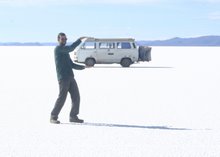
I guess we're not really used to being back on the road and having to cook for ourselves. When we were at our homestay in Xela, Dona Juana made us breakfast at 8, lunch at 1:30, and dinner at 7:30. Usually fresh, handmade tortillas and rice and vegetables we didn't recognize. We were thinking to ourselves that it would be nice to be able to decide what we were going to eat, and to eat when we felt like it, but we haven't quite figured that one out yet. Yesterday when we were at the giant market, it somehow didn't seem like the right time to buy vegetables. And today, when we were working on the van beside Lake Atitlan, it didn't seem like the right time to buy vegetables. Not when we were walking into town to go to the internet cafe, either. Later. In Mexico, the tiendas all had some fresh veggies, some avocados, limes, tomatoes, cans of salsa verde.
Turns out the Guatemalan tiendas have fruit juice, every kind of hard liquor you can name, lots of hot sauce, bottled water, and ketchup. So dinner tonight was beans, cous cous, nutritional yeast, and ketchup. It sorta tasted like mac and cheese, but with beans. It actually wasn't half bad (god, I was hungry).
We've been feasting our eyes on textiles, instead, I guess. Yesterday we went to the big market in Chichicastenango. The best market I've ever seen, bar none. And we ran into our friends Linda and Maggie from Xela, even better! We had friends to drink beer with again.
The stuff for sale was out of this world. Gorgeous, giant Mayan calendars, woven and embroidered clothes of every possible color (usually all at once), bags of every size and material, never mind the frying chicken and toasting tortillas. It was bewildering. We wandered around for a couple of hours on total sensory overload. Here's a picture of Douglas at the stall where we bought a Mayan calendar.

We are *loving* Guatemala. We haven't even left yet, and already I'm thinking that we have to come back.


















